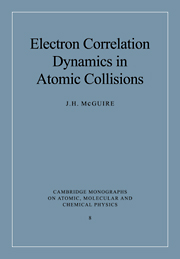Book contents
- Frontmatter
- Contents
- Preface
- 1 Introduction
- 2 Single electron transition probabilities
- 3 Formulation of multi-electron transition probabilities
- 4 Independent electron approximation
- 5 Statistical methods
- 6 Correlated multi-electron electron transition probabilities
- 7 Perturbation expansions
- 8 Projectiles carrying electrons
- 9 Reactions with photons
- 10 Relations between charged particle and photon reactions
- Appendices
- References
- Index
1 - Introduction
Published online by Cambridge University Press: 11 September 2009
- Frontmatter
- Contents
- Preface
- 1 Introduction
- 2 Single electron transition probabilities
- 3 Formulation of multi-electron transition probabilities
- 4 Independent electron approximation
- 5 Statistical methods
- 6 Correlated multi-electron electron transition probabilities
- 7 Perturbation expansions
- 8 Projectiles carrying electrons
- 9 Reactions with photons
- 10 Relations between charged particle and photon reactions
- Appendices
- References
- Index
Summary
This introductory chapter begins with a review of uncorrelated classical probabilities and then extends these concepts to correlated quantum systems. This is done both to establish notation and to provide a basis for those who are not experts to understand material in later chapters.
Probability of a transition
Seldom does one know with certainty what is going to happen on the atomic scale. What can be determined is the probability P that a particular outcome (i.e. atomic transition) will result when many atoms interact with photons, electrons or protons. A transition occurs in an atom when one or more electrons jump from their initial state to a different final state in the atom. The outcome of such an atomic transition is specified by the final state of the atom after the interaction occurs. Since there are usually many atoms in most systems of practical interest, we can usually determine with statistical reliability the rate at which various outcomes (or final states) occur. Thus, although one is unable to predict what will happen to any one atom, one may determine what happens to a large number of atoms.
1 Single particle probability
A simple basic analogy is tossing a coin or dice. Tossing of a coin is analogous to interacting with an atom. In the case of a simple coin there are two outcomes: after the toss one side of the coin (‘heads’) will either occur or it will not occur.
- Type
- Chapter
- Information
- Electron Correlation Dynamics in Atomic Collisions , pp. 1 - 15Publisher: Cambridge University PressPrint publication year: 1997

